- Submissions

Full Text
COJ Nursing & Healthcare
Publications Trends in Major Anesthesiology Journals: A 20-Year Analysis of Five Top-Ranked Journals in The Field
Stefan Koppert1*, Michael Weißenbacher1,2, Andreas Wieser3, Christoph Zelger4, Markus Hermann1, Till Köhler1 and Ralf Heudorfer4
1Department of Anesthesiology, Germany
2Department of Neurosciences, Italy
3Department of Cardiology, Germany
4Department of Anesthesia and Intensive Care, Germany
*Corresponding author: Stefan Koppert, Department of Anesthesiology, Erfurt, Germany
Submission: February 14, 2022Published: August 01, 2022

ISSN: 2577-2007Volume7 Issue5
Abstract
Background: With the intention to quantify the importance of a medical journal, the impact factor (IF) was introduced. It has become a de facto fictive rating instrument of the importance of medical journals. Also, it is often used to asses the value of the individual publications within the specific journal. The aim of the present study was to analyze publication trends over 20 years in five high-ranked anesthesiology journals.
Methods: The Medline (NCBI) database google.de was used for analysis which was restricted to the following journals:
a) Anesthesiology
b) British Journal of Anaesthesia
c) Journal of Neurosurgical Anesthesiology
d) Anesthesia & Analgesia
e) Anaesthesia.
Specific publication parameters (IFs, number of pages and authors, etc.) were retrived using the PubMed download function and imported into Microsoft Excel for further analysis.
Conclusion: The IF, as well as the number of articles per year and the number of authors per article, increased significantly. In contrast, the number of pages per article remained comparable during the period analyzed.
Result:The mean IF of the five journals analyzed increased significantly within the study period (1991 vs. 2010; +65.81%). However, the absolute number of case reports decreased significantly by 54.7% since 1991. The journals Br J Anaesth (12.2%), J Neurosurg Anesthesiol (51.9%), and Anesth Analg (41.2%) showed significant increases in the number of publications per year. The mean number of authors increased significantly in all the journals from 1991 to 2010 (3.0 vs. 4.3; +43.3%).
Keywords:Impact factor; Scientific publication; Scientific journal; Publication trend
Keywords:OAJ: Open Access Journals; IF: Impact Factor; ISI: Institute for Scientific Information; NCBI: National Center for Biotechnology Information; RCT: Randomized Controlled Trials
Introduction
The scientific productivity of an institution or person in medical research is reflected by the number of published articles [1]. However, both medical science and publication options have changed dramatically over the last several years. Publishing medical data in the new Open Access Journals (OAJs) and via the World Wide Web (WWW) has gained significant importance recently. Although the classic printed journal was the standard for many years, it is now easily possible to publish peer-reviewed medical work without printing on paper. Publishing scientific medical papers remains the standard in medicine with regard to scientific reputation. To quantify the importance of a medical paper, the Impact Factor (FI) was introduced [2] by the Institute for Scientific Information (ISI, Thomson Scientific/Thomson Corporation, New York, NY, USA) in the 1960s. The IF is a citation index calculated for a specific journal by dividing the number of citations within the last two years by the number of articles published [3,4]. Therefore, it is a fictive instrument to rate the quality of a journal and the importance of an article because it is published within a specific journal [5]. The IF is relevant in medical research because it significantly impacts publication practice [6] and it has also gained enormous significance for reserch department funding [3]. The aim of the present study was to analyze the publication trends over 30 years in five high-ranked anestesiology journals in Medline/PubMed [7]. we focused primairily on delineating trends in the IFs of the three of four journals, as well as the numbers, types, and characteristics of each publication.
Material and Methods
Journals
The Medline (National Center for Biotechnology Information, NCBI, Rockville Pike, MD, USA) database PubMed (http:// www.pubmed.com) was used for analysis [7]. Five high-ranked anesthesiology journals (excluding pain medicine), according to the Institute for Scientific Information (ISI, Thomson Scientific, Rockville Pike, MD, USA), were identified using InCites™ [2]. These top-ranked journals were selected by the highest IF in 2010. The IFs of these journals were gethered to analyze the trend in IF for each journal during the period from 1991 to 2010 [2].
Further analysis was restricted to the following journals
I. Anesthesiology
II. British Journal of Anaesthesia (Br J Anaesth)
III. Journal of Neurosurgical Anesthesiology (J Neurosurg
Anesthesiol)
IV. Anesthesia & Analgesia (Anesth Analg)
V. Anaesthesia.
Data acquisition
For specific data analysis, the following publication information
was recorded in the following data sets
I. country of origin
II. article type (i.e., Randomized, Controlled Trial [RT], clinical
trial, comparative study, or case report)
III. number of articles per year and journal [n]
IV. number of pages per article [n]
V. number of authors per article [n].
Letters to the editor, editorials, and comments were excluded from the analysis because they are not necessarily based on scientific, peer-reviewed data. All published articles from these journals were gathered by direct data import from PubMed via Microsoft Excel® 2003 Microsoft Redmond WA, USA for each year (1991-2010) and for each of the five journals (search string e.g., “Anesthesiology”[Journal] AND (“2006/01/01”[PDAT]: “2006/12/31”[PDAT]). Data were retrieved using the PubMed download function (XML data format; “Extensible Markup Language“) and were imported into Microsoft Excel for further analysis.
Statistical analysis
Descriptive statistics were performed by using Microsoft Excel® 2003. The t-test and the X²-test were used for the statistical analysis. A value of p>0.05 was considered statistically significant.
Result
Impact factor analysis
Trends in the IF for each journal and year over the 20-year time frame (1991-2010) were gathered (Figure 1). During this period, the IFs of all journals increased (2.249 in 1991 vs 3.639 in 2010; i.e.,+61.81%). The IF of J Neurosurg Anesthesiol increased from 0.638 in 1992 to 2.205 in 2010, i.e.,+245%. The smallest increase was +41.03% for Anesth Analg (from 1991 to 2010).
Figure 1:The trend in Impact Factors (IF) among the top five anesthesiology journals [2]. y-axis shows the years analyzed and the x-axis shows the Impact Factor (IF) during that time.
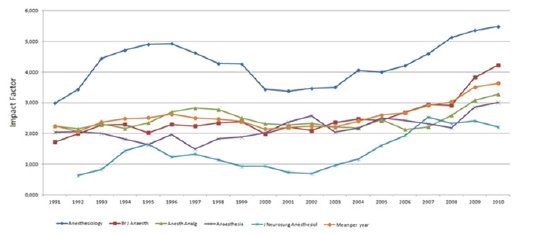
Country of origin
A total of 42,549 articles, containing 183,763 pages written by 154,437 authors, were found between January 1, 1991, and December 31, 2010, in the five journals. Among these articles, the greatest numbers of publications were submitted from the US (31.05%) (Table 1), followed by the UK (13.64%), Japan (9.24%), Germany (7.68%), and France (6.22%).
Table 1:Country of origin, number of publications, and resulting rank (1991 to 2010).
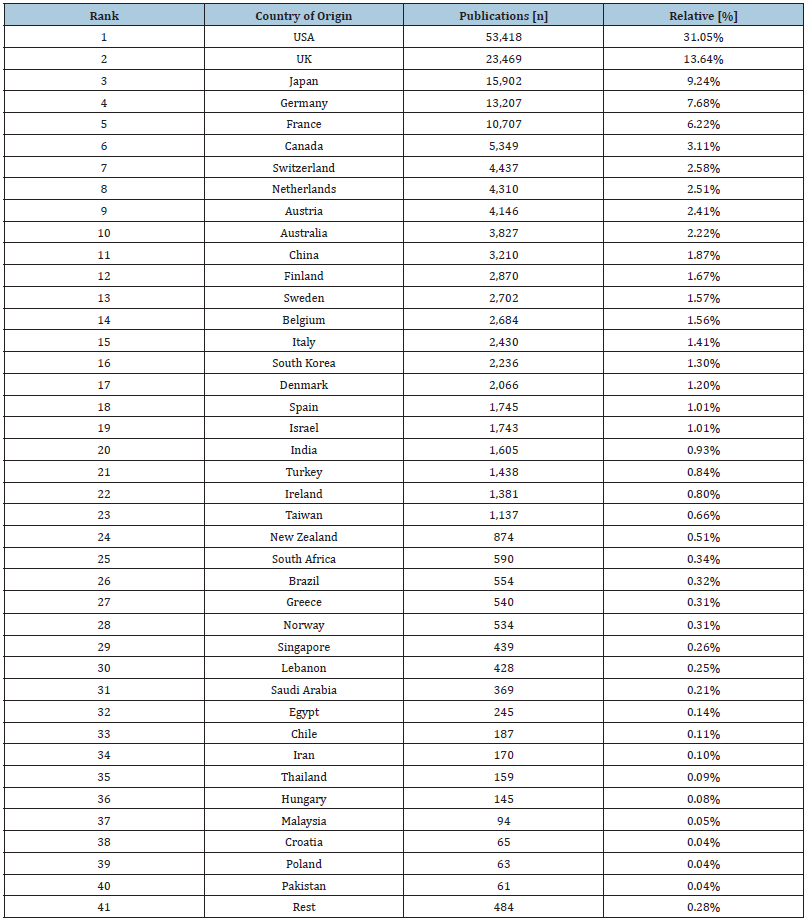
Article type
The absolute number of comparative studies and Randomized, Controlled Trials (RCT) was comparable between 1991 and 2010 (Figure 2) with minor changes during that time-frame. The number of case reports also varied from year to year; however, the absolute number of case reports decreased significantly by 45.8% between 2003 and 2010 and by 54.7% between 1981 and 2001 (p<0.0001) (Figure 2).
Figure 2:Publication types (case reports, comparative studies, and Randomized Controlled Trials [RTCs]).

Articles per year
During the time frame analyzed, the mean number of articles per year in each journal [n] was 425±226. Atlogether, 42,549 articles were published in the five journals. Anesth Analg (n=14,085 of 42,549; 33.1%) published the most articles, folowed by Anesthesiology (23.4%), Anaesthesia (22.5%), Br J Anaesth (18.6%), and J Neurosurg Anesthesiol (2.4%). In Anesthesiology, the mean number of articles published per year was 498.8±67.6 (maximum n=628 in 1999) (Figure 3). Compared to 1991, the number of articles per year decreased by 5.0% in this journal until 2010 (p=0.009). In Anaesthesia, a decrease of 45.1% (p<0.0001) in the mean number of articles published was also observed between 1991 and 2010. In contrast, the journals Br J Anaesth (+12.2%; p=0.816), J Neurosurg Anesthesiol (+51.9%; p<0.0001), and Anesth Analg (+57.2%; p<0.0001) all showed increases in the numbers of publications per year.
Figure 3:Number of articles per year [n] in the top five anesthesia journals.
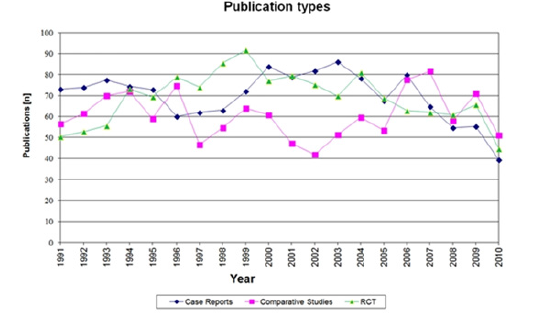
Pages per article
Although the mean number of pages per article (5.3±1.4) did not change between 1991 and 2010 (Figure 4) (p<0.05), there were variations among the years. In the Br J Anaesth only, the pages per article remained stable during the time frame analyzed (p>0.05). In the other journals, the pages per article increased (Anesthesiology, Anesth Analg, Anaesthesia) or decreased (J Neurosurg Anesthesiol).
Figure 4:Pages per article [x] in the top five anesthesia journals.
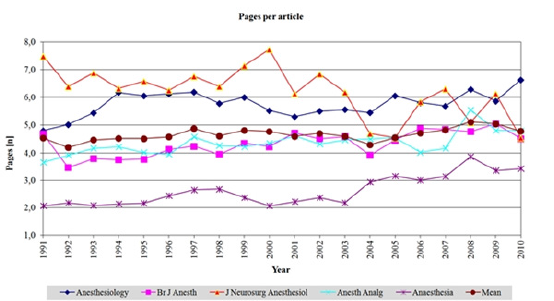
Number of authors per article
The mean number of authors per article [n] was 3.6±0.7, which increased significantly in all journals from 1991 to 2010 (3.0 vs. 4.3, a relative increase of 53.3%; p<0.0001) (Figure 5). Anesthesiology showed the smallest increase (1991 vs 2010, 3.43 vs 4.28 authors; relative increase of 24.8%), followed by Anaesthesia (2.3 vs 3.2; +39.1%), Anesth Analg (3.35 vs 4.67; +39.4%), and Br J Anaesth (3.08 vs 4.62; +50%); the greatest increase was observed in the J Neurosurg Anesthesiol (3.0 vs. 4.8; +62.5%).
Figure 5:Number of authors per article [n] in the top five anesthesia journals (1981 to 2010).
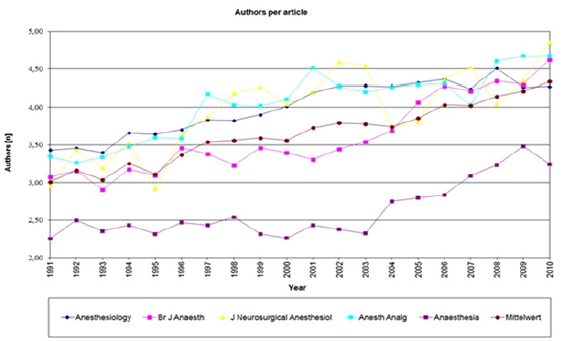
Conclusion
The present study could provide some interesting insight into the trends in several specific publication measurements. When interpreted in the global context of biomedical publishing, the present study identified the potential publication strategies used to enhance the prominence of anesthesia journals.
The IF (mean: +61.81%), as well the number of articles per year (+57.2%) and the numbers of authors per article (+43.3%) increased signficantly between 1981 and 2000. In contrast, only the number of pages per article remained comparable during the period analyzed. It is impossible to offer definitive answers explaining why these measures changed, but these changes could partialy be due to the authors (e.g., number of authors per article). In our opinion, the publication process would have greater transparency if journals would provide such data at the end of each year.
Discussion
The aim of the present study was to analyze publication
parameters in five top-ranked anesthesia journals over a 20-year
time frame.
The following journals were analyzed:
I. Anesthesiology
II. Br J Anaesth
III. J Neurosurg Anesthesiol
IV. Anesth Analg
V. Anaesthesia
The absolute number of scientific publications has been rising since the 18th century [8]. Since then, the number of publications has doubled every 10 to 15 years [8]. This trend has been especially true in Anästhesiology, which has gained relevance recently, thereby resulting in a concomitant increase in scientific publications [9-11].
Country of origin
In the present study, the vast majority of publications were submitted from the US, followed by Western Europe and Australia (Table 1). These data are in concordance with Li et al [10]. study, analyzing journals between 2000 and 2009 [12]. The top five countries in the present investigation were among the top seven countries [12]. Figueredo and colleagues also found that the USA, the UK, Japan, Germany, Canada, and Spain published the most articles in anesthesia journals between 1997 and 2001 [13]. In their study, the largest increase in scientific production in anesthesiology was observed in Germany [13]. However, they concluded that the geographical distribution of scientific production must not only be analyzed in absolute terms but should also be evaluated relative to other variables, such as financial spending on research and development, as well as population growth [13].
Articles per year
Altogether, 152,549 articles were published in the five journals within the time frame analyzed. In Anesthesiology, the mean number of articles published per year was 498.8±67.6. Compared to 1991, the number of articles per year decraesed by 55.0% until 2010. In Anaesthesia, a decrease of 45.1% in the mean number of articles published was observed in the same period. In order to attain higher quality in journal articles and consequently a higher IF, several prequisites for article aceptance have been developed in recent years. Currently, clinical trial registration, as well as plagiarism checks and ethical committee approvals, is a standard practice. Although this practice ensures higher-quality articles, it also could result in a decrease in the number of accepted publications. [14] confirmed these results in 188 different anesthesiology journals. The authors postulated that this decrease might be associated with an increasing IF. Feneck and colleagues also found a decrease in research publications from the UK in anesthesia journals from 1997 to 2006 [15]. In our study, the journals Br J Anaesth, J Neurosurg Anesthesiol, and Anesth Analg showed significant increases in the numbers of publications per year (1991 to 2010). Another study published by Li et al. [10] showed that these journals have decreasing numbers of articles while analyzing the period of 2000-2009 only. However, it is acepted that the absolute number of scientific publications is less important due to the difficulties that can ocur in quality assessments of studies [16].
Impact factor analysis
Among the many surrogate parameters, the IF from the Institute for Scientific Information [2] has achieved the greatest popularity, especially in government research and medical schools [3,4]. It is a common, but fictive, instrument for quantifying the importance of a medical paper based on citations [17] and it is used to rate the quality of a (medical) journal [4,5]. Today, the IF also has enormous significance for research department funding [3,18]. The IF was originally designed and sold as a product for advertisers, i.e., it was sold to advertisers, at very high costs for the purpose of helping them target their advertisments to the most widely read journals within the set of journals that were read by potential buyers of their products [19]. Although the IF is not an absolute measurement of the quality of a journal [x], it can quantify the influence of a journal in the medical field [4]. Because the IF influences medical research and funding [18], changes in the IF can significantly affect publication practice [6]. During the time frame analyzed, the IF of all journals in the present study increased (2.249 in 1991 vs 3.639 in 2010; i.e., +61.81%). This phenomenona is not new and has been observed for several years also by other authors [20]. The median and highest IF in the present study have increased since 2005 [3]. This increase in IF has been observed for years [3,20]. One main reason for the IF boom is the growth of research production [4,20,21]: More researchers are writing more contributions in more journals [22,23] with more references [3]. In contrast, several journals have decreasing IFs, especially those in non-English languages and those that are difficult to access.
However, IFs can be manipulated by many strategies: selfcitation; increasing editorials and reviews (more likely to be cited); and a reduction of the number of case reports (less likely to be cited) [4,16,18]. Therefore, the importance of the IF remains controversial [24] and there is no established current alternative available to rate the quality of scientific publications [4]. As the main factor that could lead to overestimate the IF is the amount of self-citations within a journal, in 2010 Landoni et al. [25] have suggested to apply a new metric called “new IF 50%”. This instrument, accounting the weight of self-citation with the aim of limiting their influence on the final result, is employed when the self-citation percentage is more than 20% of the total. Other authors present innovative journal metrics as IF substitute, e.g. the CAPCI factor (Citation Average of Citable Item) by E.P. Diamandis [26]. In adition, the International Commite of Medical Journal Editors (ICMJE) has outlined guidelines for the authorship of scientific papers [27], but it remains unclear whether authors comply with these prequisites when submitting manuscripts. Therefore, the contributions of each author should not only be judged by the authors themselves but also by the editors to prevent misconduct by researchers and inadequate authorship.
Article type
Although the absolute numbers of comperative studies and RCTs were comparable between 1991 and 2010 there were significant variations per month. In contrast the absolute number of case reports decreased significantly by 45.8% between 2003 and 2010 and by 54.7% between 1991 and 2010. Li et al. [10] also found a decreasing number of articles per year (both clinical studies and RCTs) when analyzing several different journals. Because case reports are cited less frequently in the years after their publication, publishing them can be conterproductive for a journal striving to obtain a higher IF. Therefore, publishing fewer case reports to enhance the IF might have motivated the major anesthesiology journals that were analyzed in the present study.
Pages per article
The mean number of pages per article was 4.3±9.4 and did not change between 1991 and 2001 (Figure 4) (p>0.01). However, only in the Br J Anaesth the pages per article remained stable during the time frame analyzed (p>0.05). For Anesthesiology, Anesth Analg, and Anaesthesia the pages per article increased but increased significantly for J Neurosurg Anesthesiol. However, due to lower publications costs and the avialability of electronic publication [28], restrictions on the length of articles might not have been as relevant as such restrictions previously were.
Number of authors per article
The mean number of authors per article was 3.6±0.7 in the present study, and it increased signficantly in all journals analyzed between 1991 and 2010 (3.0 vs 4.3: relative increase of 43.3%). This increase was the lowest in Anesthesiology (+54.8%) and was significantly higher in the other journals (+62.5%). The increase in the number of authors per articles has also been a comonly observed phenomenon in other medical journals and in different countries [29,30]. This phenmomenon has been observed even in the most highly ranked journals (N Engl J Med, J Am Med Assoc, and The Lancet) [29,30]. Kumar et al. [30] reported a gradual increase in the average number of authors over the past three decades [30]. Drenth et al. also found an increasing number of authors in the Br Med J [31]. These findings are congruent with the results of the present study, although different medical fields were analyzed. A number of reasons could be responsible for this phenomenon [30]. There has been an increasing trend toward coperation among researchers in multiple disciplines and an increase in multi-centre studies, as well as an increase in the complexity of research projects, which could facilitate collaboration and result in an increase in the number of authors per article [30,31]. Aditionally, it has been shown that studies with many authors are cited more often than studies with fewer authors, thereby contributing to the IF of the journal [23].
Limitations
The analysis in the present study was restricted to only five high-ranked anesthesiology journals listed in the Medline and PubMed database. All these journals are published in English. Due to the descriptve character of this study, it was not possible to delineate variations in the specific publications measured, but it was not possible to provide definitive answers why these changes ocurred. However, we used a 20-year time frame to compensate for variations in specific years. Although the journals were selected from the anesthesiology category of JCR, a few of the selected journals cover disciplines beyond anesthesia research.
References
- Stossel T, Stossel S. (1990) Declining American representation in leading clinical-research journals. N Engl J Med 322(11): 739-742.
- SCImago Lab. SCImago Journal and Country Rank.
- Baethge C (2012) Impact factor--a useful tool, but not for all purposes. Dtsch Arztebl Int 109(15): 267-269.
- Caon M (2017) Gaming the impact factor: where who cites what, whom and when. Australas Phys Eng Sci Med 40(2): 273-276.
- Saha S, Saint S, Christakis D (2003) Impact factor: A valid measure of journal quality? J Med Libr Assoc 91(1): 42-46.
- Kaltenborn K, Kuhn K (2003) The journal impact factor as a parameter for the evaluation of researchers and research. Medizinische Klinik 98(3): 153-169.
- National Center for Biotechnology Information.
- Rider F (1944) The scholar and the future of the research library: A problem and its solution. The Johns Hopkins University Press, New York, USA, pp. 108-112.
- Seldon T (1971) Anesthesia and analgesia-50 years of publication. Anesth Analg 50(4): 571-577.
- Li Z, Qiu L, Wu F, Yang L, Sun S (2011) Scientific publications in international anaesthesiology journals: A 10-year survey. Anaesth Intensive Care 39(2): 268-273.
- Tripathi R, Blum J, Papadimos T, Rosenberg A (2011) A bibliometric search of citation classics in anesthesiology. BMC Anesthesiology 11: 24.
- Cappell M (2009) A more than one-hundred-fold higher per capita rate of authorship of five democratic nations versus their relatively undemocratic neighboring nations among 6,437 articles in 14 medical journals: Does democracy and civil liberties promote intellectual creativity and medical research? Dig Dis Sci 54(8): 1609-1620.
- Figueredo E, Sánchez-Perales G, Muñoz-Blanco F (2003) International publishing in anaesthesia-how do different countries contribute? Acta Anaesthesiol Scand 47(4): 378-382.
- Feneck R, Natarajan N, Sebastian R, Naughton C (2008) Decline in research publications from the United Kingdom in anaesthesia journals from 1997 to 2006. Anaesthesia 63(3): 270-275.
- Pandit J (2008) Anaesthetic research in the United Kingdom: Publishing or perishing? Anaesthesia 63(3): 225-227.
- Garfield E (1999) Journal impact factor: A brief review. Can Med Assoc J 161(8): 979-980.
- Seglen P (1997) Why the impact factor of journals should be used for evaluating research. Brit Med J 314: 498-502.
- Pulverer B (2013) Impoact fact-or fiction? EMBO J 32(12): 1651-1652.
- Chorus C, Waltman L (2016) A large-scale analysis of impact factor biased journal self-citations. Plos One 11(8): 0161021.
- Garfield E (1972) Citation analysis as a tool in journal evaluation. Science 178(4060): 471-479.
- Mabe M (2003) The growth and number of journals. Serials 16(2): 191-197.
- Wuchty S, Jones B, Uzzi B (2007) The increasing dominance of teams in production of knowledge. Science 316(5827): 1036-1039.
- Pirmez C, Brandão A, Momen H (2016) Scientific journal publishing is too complex to be measured by a single metric: Time to review the role of the impact factor! Mem Inst Oswaldo Cruz 111(9): 543-544.
- Landoni G, Pieri M, Nicolotti D, Silvetti S, Landoni P (2010) Self-citation in anaesthesia and critical care journals: Introducing a flat tax. Br J Anaesth 105(3) :386-387.
- Diamandis E (2017) The Journal Impact Factor is under attack -use the CAPCI factor instead. BMC Medicine 15(1): 9.
- International Committe of Medical Journal Editors (1997) Uniform requirements for manuscripts submitted to biomedical journals. N Engl J Med 336: 309-315.
- Ranasinghe P, Perera Y, Abeygunasekara A (2011) The process and costs of publishing medical journals in Sri Lanka: An economic evaluation. BMJ Open 1(1): 000057.
- Ludwig S, Baethge C (2010) Focus of Research: The Deutsches Ärzteblatt can look back on a long tradition of publishing original articles in medical science. Dtsch Arztebl Int;107(18): 317-319.
- Kumar G, Mahawar K (2007) The number of authors in articles published in three general medical journals. Nat Med J India 20: 101-102.
- Drenth J (1998) Multiple authorship: The contribution of senior authors. J Am Med Assoc 280(3): 219-221.
- Montorsi F (2007) Current and future trends of publications in urological journals: The increasingly leading role of Europeans. Eur Urol J 52(4): 939-942.
© 2022 Stefan Koppert. This is an open access article distributed under the terms of the Creative Commons Attribution License , which permits unrestricted use, distribution, and build upon your work non-commercially.
 a Creative Commons Attribution 4.0 International License. Based on a work at www.crimsonpublishers.com.
Best viewed in
a Creative Commons Attribution 4.0 International License. Based on a work at www.crimsonpublishers.com.
Best viewed in 







.jpg)






























 Editorial Board Registrations
Editorial Board Registrations Submit your Article
Submit your Article Refer a Friend
Refer a Friend Advertise With Us
Advertise With Us
.jpg)






.jpg)














.bmp)
.jpg)
.png)
.jpg)










.jpg)






.png)

.png)



.png)






